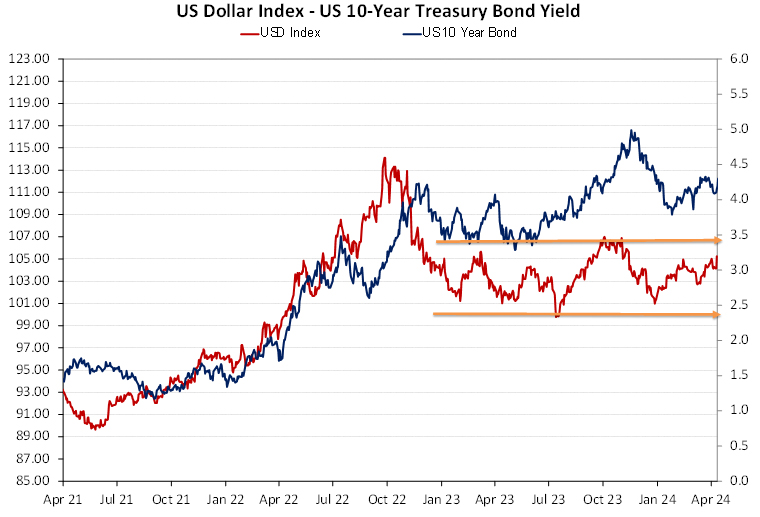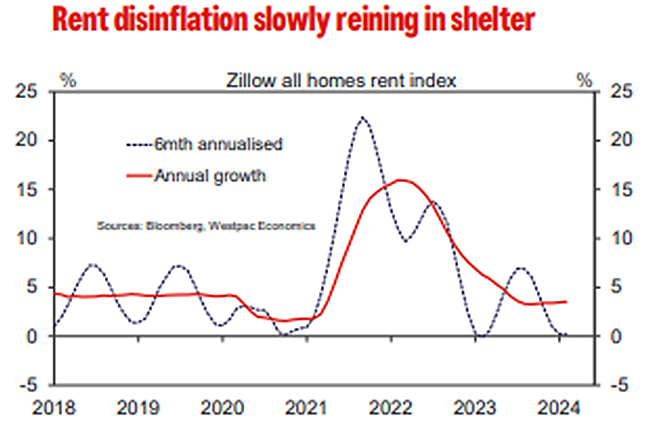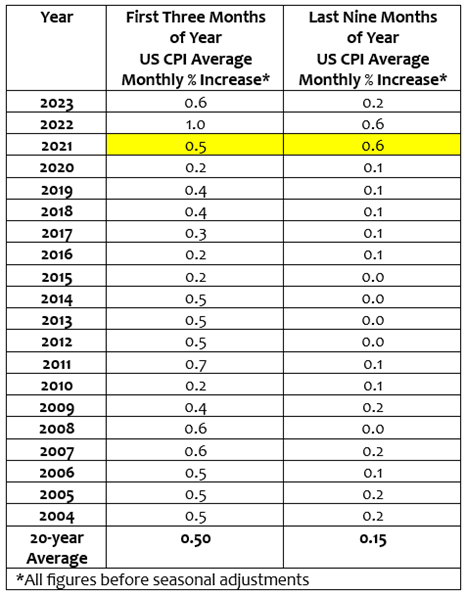
Summary of key points: -
- Another bout of US dollar strength as markets re-price Fed interest rate cuts
- Will the higher US inflation continue?
The US CPI inflation result for the month of March, released last week, has proven to be sufficiently concerning on the future inflation outlook that it has powered both the US dollar value and US bond yields significantly higher. Whilst the inflation increase “miss” of 0.40% for the month was only marginally above the prior consensus forecast of +0.30%, it has been the culmination of three months of similar sized increases this year that has scared the horses in the currency and bond markets. The Federal Reserve did signal to the market a few weeks back that the inflation path lower to the 2.00% target could be a bumpy ride, however the adverse market reaction suggests that many do not believe US inflation can fall any lower than 3.00%. Both short-term and long-term market interest rates are sharply higher, the 2-year bond yield at 4.89% and the 10-year yield at 4.51%. The current interest rate market pricing now only suggests two 0.25% cuts in the 5.50% Fed Funds rate over the next two years.
On top of US interest rates increasing, the US dollar also received a boost against the Euro as monetary policy diverges across the Atlantic. The European Central Bank intimated that they could be cutting their interest rates as soon as June, the Euro tumbling on the double whammy of bad news from $1.0860 to $1.0650 at the market close on Friday. As a consequence of the renewed US dollar strength, the Kiwi and Aussie dollars have both been pushed down to previous lows. The NZD/USD rate below 0.6000 to 0.5940 and the AUD/USD rate below its medium-term support level of 0.6500 to 0.6465.

Over the last 15 months the US dollar value has oscillated between 100 and 106 on the USD Dixy Index (refer chart above), moving up and back down on multiple occasions as the FX markets reacted to both stronger economic data (interest rates higher for longer, being USD positive) or alternatively weaker data (prompting lower interest rates and thus USD negative). The USD Index has closely followed 10-year bond yields in both directions. Since the start of 2024 the direction of both bond yields and the USD Index has been higher as both US employment and inflation data has printed stronger than forecast. The high anticipation at the start of the year that the Fed would slash interest rates by up to 1.50% in 2024 has been completely destroyed.
In looking forward, the question is whether the US economy continues to produce strong jobs growth and inflation struggles to move below 3.00% to 2.00%. If the data remains strong, the US dollar will remain strong and push well above the 106/107 barrier at the top in the chart above. If jobs growth falters and inflation does not stay above 3.00% and decreases to the 2.00% Fed target, then the US dollar will reverse lower to the bottom of the channel at 100.
The future direction for the NZD/USD exchange rate is correspondingly directly related to the aforementioned potential USD Index scenarios. A return to 100 on the USD Index is equivalent to 0.6300 NZD/USD. The USD Index remaining in the 106/107 zone keeps the NZD/USD exchange rate below 0.6000.
The irony of the massive bond and FX market reaction the March CPI inflation results is that it is not the measure of inflation in the US that the Federal Reserve respect or rely on. They prefer the PCE deflator measures which is due for release on Friday 26th April. Current forecasts for the PCE inflation increase (headline) over the month of March is for only a 0.10% lift, reducing the annual PCE headline rate of inflation to 2.10%. The core PCE measure (excluding energy and food) is forecast to reduce from 2.80% to 2.30% on an annual basis.
The bond and FX market reactions to this more accurate picture of inflation in the US economy today is likely to be the direct opposite of what has been seen over this last week i.e. bond yields and the USD sharply lower. The Fed’s inflation target is 2.00% and on their preferred measure they will be very close to that target in two weeks’ time. For this reason, we still prefer the weaker USD scenario to 100 on the Dixy Index.
Will the higher US inflation continue?
There are two good reasons why the Fed prefer the PCE measure of inflation over the CPI index: -
- The extraordinarily lagged nature of the shelter/rent data renders the CPI inaccurate as a measure of current inflation. Shelter/rents have a dominant 40% weighting in the core CPI inflation measure.
- There is a well proven bias to larger CPI inflation increases over the first three months of the year compared to the last nine months. Many American companies adjust their selling price of good and services once per year, in January or February. Seasonal adjustments to the data is meant to smooth these effects out, however that does not seem to occur.
In the March CPI data, it was again the lagged increases of shelter/rents that caused the higher +0.40% result. Shelter/rents are still increasing at 5.70% per annum according to the CPI measure. Such an increase is a long way from the reality of changes to current market rents for houses and apartments in the US today. The chart below from the Zillow rental index confirms that actual market rents have flatlined at 0.0% on an annualised basis over the last six months (black dotted line).
It is really surprising that the FX and bond markets in the US base their decisions to buy or sell on such inaccurate and discredited economic data.

The pronounced skew or bias in inflation over first three months of the year always being higher than the last nine months is due to US companies adjusting their selling prices once per year at the start of the year. In 2024, that pattern has repeated, as first three months’ CPI increases have been +0.30, +0.40% and +0.40% respectively, well above the increases in October, November and December 2023.
The table below summarises the average monthly CPI increases over the first three months of the year compared to the last nine months of each year over the last 20 years. There was only one year (2021) that the first three months recorded a lower average, due to substantial price increases from April to December 2021 from increases in global commodity prices, excessive demand from 0% interest rates at the time and Covid-related supply chain disruptions. A similar analysis of the previous 20-year period 1984 to 2004 would produce a similar result.
The difference between the first three months (average +0.50%) and the last nine months (average +0.15%) is massive, something the markets and the Fed should take heed of.
The conclusion from this analysis is that the balance of 2024 should see significantly lower average monthly CPI increases than we have witnessed over the first three months. The market’s worries that US inflation cannot go any lower appear misplaced.

Daily exchange rates
Select chart tabs
*Roger J Kerr is Executive Chairman of Barrington Treasury Services NZ Limited. He has written commentaries on the NZ dollar since 1981.




We welcome your comments below. If you are not already registered, please register to comment.
Remember we welcome robust, respectful and insightful debate. We don't welcome abusive or defamatory comments and will de-register those repeatedly making such comments. Our current comment policy is here.